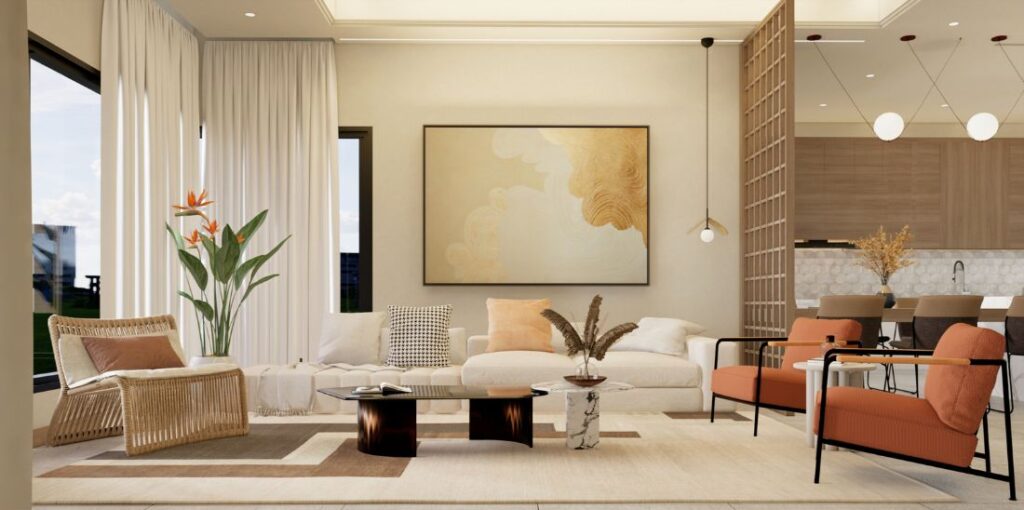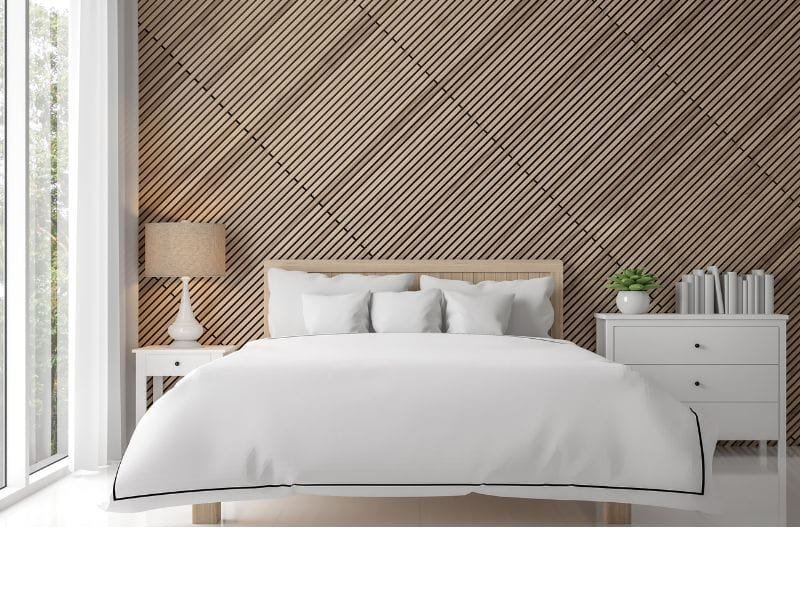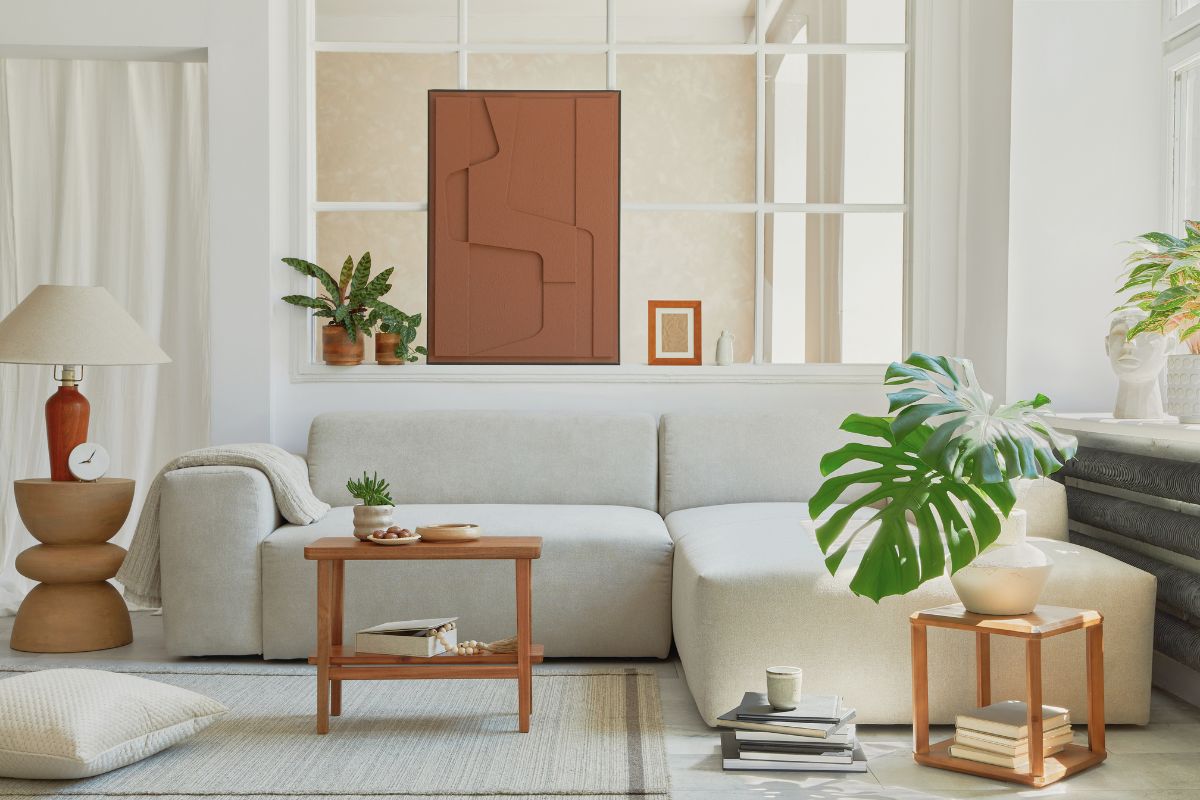Layered lighting is a fundamental aspect of interior design that enhances both the functionality and aesthetic appeal of a space. By combining ambient, task, and accent lighting, you can create a balanced atmosphere that caters to various activities while adding depth and visual interest to your home.
Find out how to utilize different types of lighting techniques for your interiors, and learn how to achieve the perfect lighting like a pro.
Three Types Of Layered Lighting
By blending ambient, task, and accent lighting, designers expertly elevate a room’s overall aesthetic. This method doesn’t just improve how we use the space—it helps set the mood, add depth, and draw attention to key areas.
- Ambient Lighting:
This is the foundational lighting that fills the room with even, general light, ensuring comfort and visibility. It’s what makes a space feel inviting and well-lit without overpowering it. Designers often use ceiling lights, recessed fixtures, or pendant lamps for this essential layer.
- Task Lighting:
This layer is all about functionality. It focuses light exactly where you need it—whether it’s over your work desk, kitchen counter, or reading nook. Examples include under-cabinet lighting, desk lamps, and track lights, all aimed at helping you accomplish specific tasks effortlessly.
- Accent Lighting:
This is the creative layer that adds drama and style. It highlights architectural features, artwork, or focal points to draw the eye and create visual interest. Spotlights, wall sconces, or table lamps used strategically elevate the room’s aesthetic and provide a more personalized touch.
When used together, these three types of lighting work in harmony, making any room not only more functional but also visually engaging and inviting.
Task Lighting
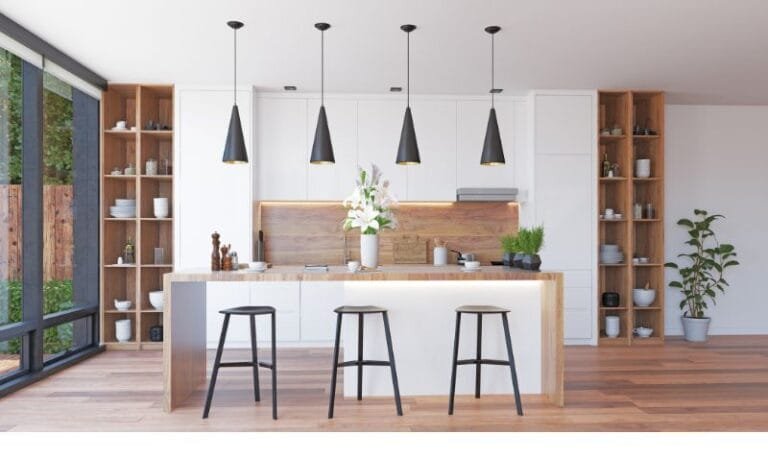
Use task lighting to provide focused illumination for activities that require more light. It enhances functionality and adds style to a room.
Examples of task lighting include:
- Desk Lamps: Ideal for reading, writing, and computer work.
- Pendant Lights: Hang from the ceiling to focus light on specific areas like dining tables or kitchen islands.
- Desk Lamps: Ideal for reading, writing, and computer work.
-
- Under-Cabinet Lights: Useful in kitchens and workspaces for illuminating countertops and work areas.
- Adjustable Floor Lamps: Provide direct light for reading or crafting, and can be moved to different areas.
- Clip-On Lights: Attach to shelves or desks for focused lighting.
- Wall Sconces: Mounted on walls to provide directed light for reading or sewing.
- Track Lighting: Adjustable fixtures that illuminate specific areas or tasks.
- Magnifying Lamps: Combine lighting with magnification for detailed tasks like electronics repair or crafting.
- Under-Cabinet Lights: Useful in kitchens and workspaces for illuminating countertops and work areas.
Ambient Lighting
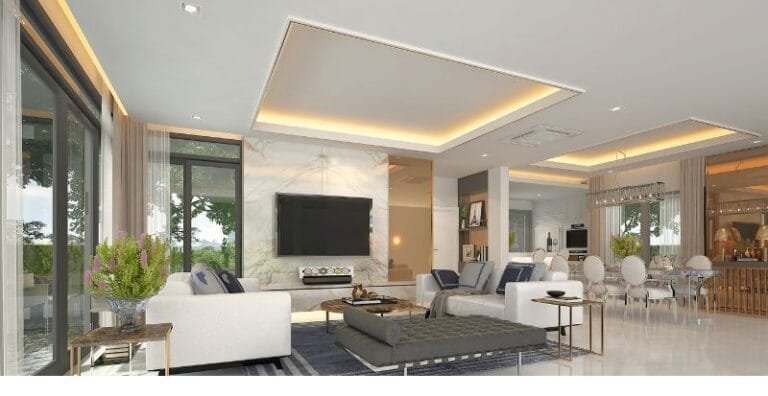
Make use of soft, diffuse lighting to provide overall illumination.
Examples of ambient lighting include:
- Ceiling Fixtures: Overhead lights such as chandeliers, flush mounts, or pendant lights that provide general illumination.
- Recessed Lighting: Embedded in the ceiling to offer unobtrusive, even light throughout a room.
- Cove Lighting: Installed in a recessed area, such as along the top of a wall, to create a soft, indirect glow.
- Floor Lamps: Provide widespread light that fills a room and complement other lighting sources.
- Wall Washers: Lights that illuminate the walls, creating soft and diffused ambient light.
- LED Strips: Installed along the edges or under shelves for subtle, even lighting.
- Sconce Lighting: Mounted on walls to provide diffuse light that enhances the overall atmosphere.
- Pendant Fixtures: Hanging lights that distribute ambient light over dining areas or living spaces.
- Ceiling Fixtures: Overhead lights such as chandeliers, flush mounts, or pendant lights that provide general illumination.
Accent Lighting
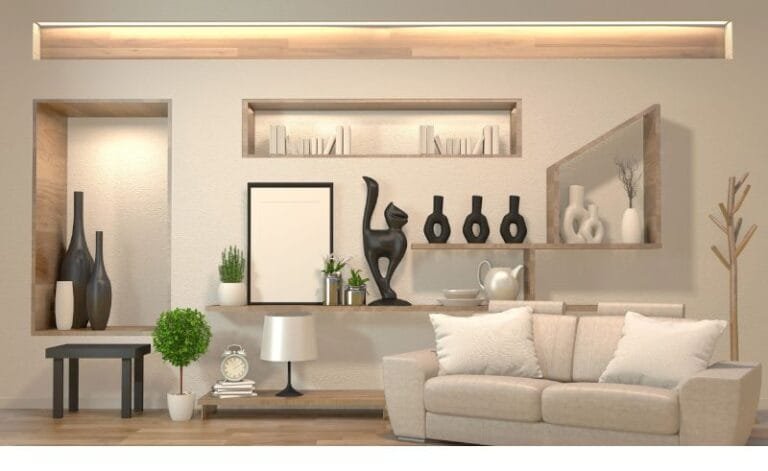
Used to highlight specific features or objects in a space, creating visual interest and depth. It focuses on emphasizing particular elements, such as artwork or architectural details, rather than providing general illumination.
Some examples of accent lighting include:
- Spotlights: Focused lights used to highlight specific objects or features, like artwork or architectural details.
- Picture Lights: Mounted above or below artwork or photographs to emphasize visual interest.
- Backlighting: Placed behind objects or on translucent panels to create a glowing effect and highlight shapes or textures.
- Under-Cabinet Lighting: Positioned under cabinets to highlight countertops and create visual interest in kitchens or workspaces.
- LED Strip Lights: Installed along shelves, along the base of furniture, or behind mirrors to provide subtle illumination that highlights features.
- Table Lamps: Used to spotlight particular areas on tables or desks, adding function and decorative flair.
- Up-Lighting: Placed on the floor pointing upwards to illuminate walls, plants, or architectural elements, creating dramatic effects.
- Floor Wash Lights: Low, angled lights that bathe the floor in light, creating an atmospheric glow and highlighting textures or patterns.
- Spotlights: Focused lights used to highlight specific objects or features, like artwork or architectural details.
Tips For Choosing The Right Lighting For Different Interior Spaces
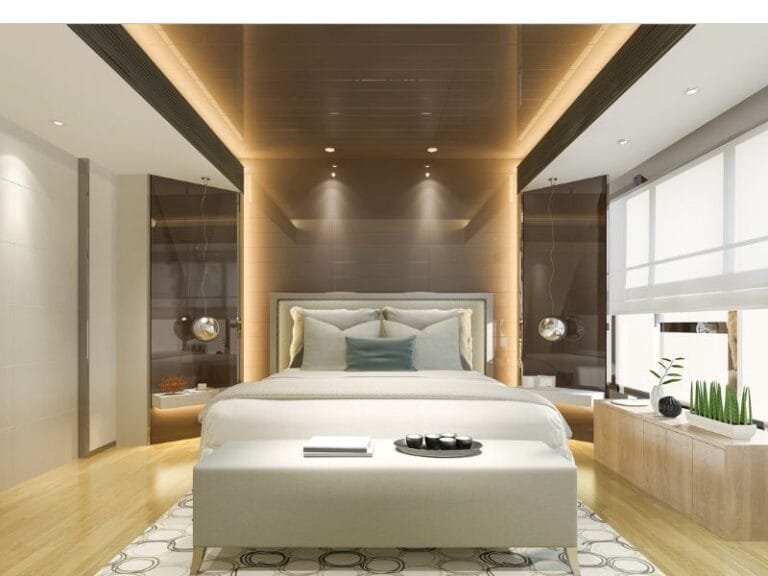
Bedroom Lighting: For a Stunning & Relaxing Space
- Layered Lighting with Warm Tones: Combine ambient, task, and accent lighting for a functional and stylish setup. Use dimmer switches or bedside lamps with adjustable, warm-toned light to create a cozy, relaxing atmosphere. Ambient lighting provides overall illumination, task lighting is perfect for focused activities like reading, and accent lighting highlights architectural details or decor.
Natural Light: Use sheer curtains or blinds to allow soft, natural daylight into your bedroom while maintaining privacy. This not only enhances the space but also helps regulate your circadian rhythm.
Avoid Harsh Blue Light: Minimize exposure to screens and blue light sources in the evening to support better sleep. Use warm, low-color-temperature lighting in your bedroom, which mimics natural sunset tones, and consider blue light-blocking glasses if screens are unavoidable before bed.
Living Room Lighting: For a Versatile & Inviting Space
Layered Lighting for Versatility: Combine ambient, task, and accent lighting to meet a variety of needs. Use ambient lighting for general illumination, task lighting for activities like reading or working, and accent lighting to highlight artwork or architectural features.
Dimmable Lights: Install dimmer switches to adjust brightness easily and create the perfect atmosphere for any occasion, from relaxing evenings to lively gatherings.
Maximize Natural Light: Enhance your living room with large windows, sheer curtains, or light-filtering blinds that allow sunlight to brighten the space while maintaining privacy when needed. Incorporating natural light creates an open, airy feel and connects your home to the outdoors.
Home Office Lighting: For Productivity & Comfort
Layered Lighting for Efficiency: Combine task, ambient, and accent lighting to create a workspace that’s both functional and inviting. Use a desk lamp with an adjustable arm and bright, focused bulbs for detailed work. Overhead lighting, like recessed lights or a modern pendant, ensures even, glare-free illumination throughout the room.
Reduce Eye Strain with Balanced Light: Incorporate accent lighting, such as wall sconces or LED strips along shelving, to reduce harsh contrasts between bright screens and darker surroundings, helping prevent eye fatigue.
Maximize Natural Light: Position your desk near a window to take advantage of daylight. Use light-filtering shades to control glare, and consider a reflective desk surface to bounce natural light and keep the room bright and lively.
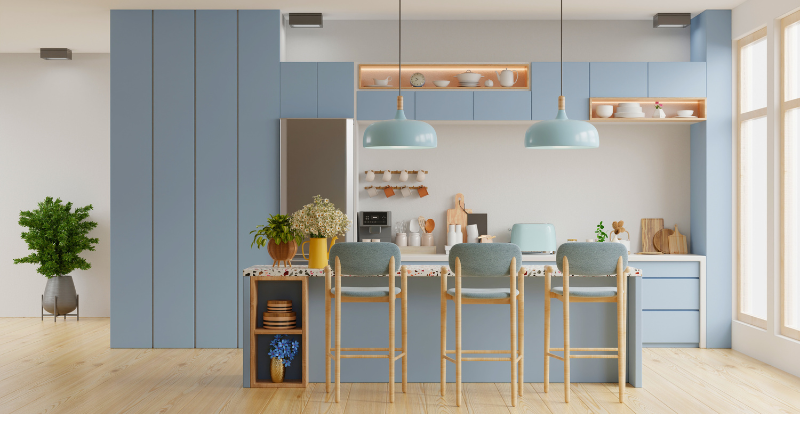
Kitchen Lighting: For a Functional & Stylish Space
Layered Lighting for Function and Style: Combine task, ambient, and accent lighting for a well-rounded setup. Use under-cabinet lights to illuminate work surfaces for precision in cooking and meal prep, and opt for stylish pendant lights or linear fixtures to brighten islands and dining areas. Recessed lighting or chandeliers add general illumination while balancing function and aesthetics.
Highlight Zones with Accent Lighting: Add flair with accent lights inside glass-front cabinets or under toe-kicks to highlight unique design features and enhance the overall ambiance.
Maximize Natural Light: Take advantage of windows or skylights to flood the space with daylight, creating an inviting and energizing environment. Position work areas to make the most of natural light, and use reflective surfaces like glossy backsplashes or light-colored countertops to amplify its effect.
Bathroom Lighting: For a Functional & Relaxing Space
Layered Lighting for Beauty and Functionality: Combine task, ambient, and accent lighting to meet both practical and aesthetic needs. Place vanity lights on either side of the mirror or above it to ensure even, shadow-free lighting for grooming.
Waterproof Overhead Lighting: Install a ceiling fixture rated for wet or damp locations, such as flush-mount lights or recessed fixtures, to provide overall illumination while maintaining safety and style.
Ambient Lighting for Relaxation: Incorporate dimmable recessed lights or wall sconces to create a serene atmosphere, perfect for unwinding in the bath or shower.
Highlight Design Features: Add accent lighting to niches, shelving, or under floating vanities to emphasize architectural details and enhance the spa-like vibe.
Optimal Lighting Tips for Non-Residential Spaces
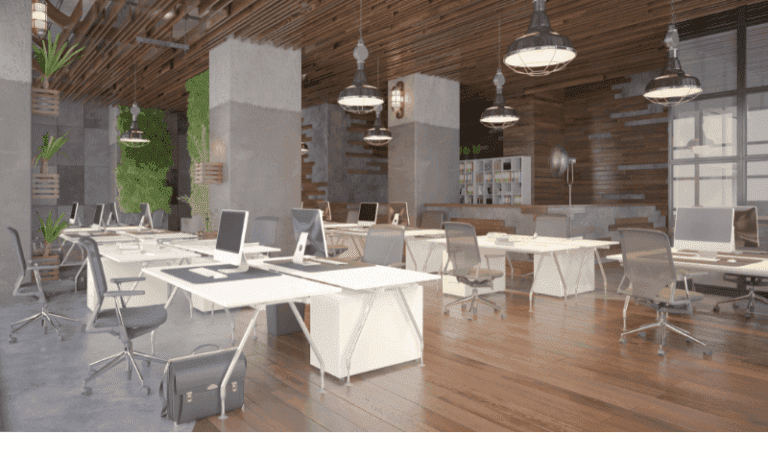
Office Lighting
Task Areas: For workstations or desks, use adjustable desk lamps or overhead lights with adjustable brightness and direction. This ensures focused lighting for detailed tasks while preventing eye strain.
Open Spaces: In large, open office areas, combine ambient lighting with focused task lighting to allow flexibility for different activities. Overhead lights, such as grid fixtures, offer general illumination, while task lamps or adjustable wall sconces can be directed where extra light is needed.
Meeting Rooms: Choose dimmable lighting to control brightness levels for various activities, from presentations to brainstorming sessions. Natural light is essential for creating a productive and positive environment, so position work areas near windows when possible.
Reception Areas: Create an inviting first impression by blending ambient lighting with accent lighting. Soft overhead lights combined with feature lighting, such as stylish pendants or wall sconces, help achieve a welcoming atmosphere that complements your brand’s personality.
Educational Institutions
Classrooms: Maximize natural light with large windows or light-filtering blinds to create a bright, welcoming atmosphere. Use adjustable task lighting at student desks to ensure focused lighting for reading or writing tasks. Soft ambient lighting provides an overall calming effect to reduce glare and eye strain.
Libraries: Offer a mix of focused task lighting, such as desk lamps or overhead lights above study areas, to support reading and focused work. Incorporate softer ambient lighting in relaxation zones to create a quiet, calming space for students to unwind.
Healthcare Facilities
- Exam Rooms: Use adjustable task lighting to ensure clear and accurate examinations. Soft ambient lighting can create a more comfortable, calming environment for patients.
- Waiting Areas: Foster a sense of calm and relaxation with soft, diffused lighting, ideal for creating a stress-free atmosphere while patients wait.
Retail Spaces
- Showrooms: Highlight products with focused accent lighting to draw attention to key items or displays. Complement this with general ambient lighting to create a well-lit and inviting space.
- Retail Stores: Balance natural light with artificial lighting to create a pleasant shopping experience. Large windows should be maximized for daylight, while artificial lighting ensures comfort during evening hours.
Restaurants & Cafes
- Dining Areas: Combine ambient lighting with focused task lighting on tables for an inviting atmosphere and ideal dining conditions.
- Bar Areas: Use dimmable lighting to set a cozy, intimate mood at the bar, allowing for flexibility during different times of day and customer needs.
- Outdoor Spaces: Incorporate string lights, lanterns, or low-level garden lighting to enhance the ambiance and create a welcoming, relaxed outdoor environment.
Point of Alignment
Lighting is key to shaping the feel and function of any space, whether it’s a home or a business. By thoughtfully layering light for both form and function, you can turn any room into a place where people feel comfortable and inspired. With a little care and planning, lighting can truly elevate your environment.

